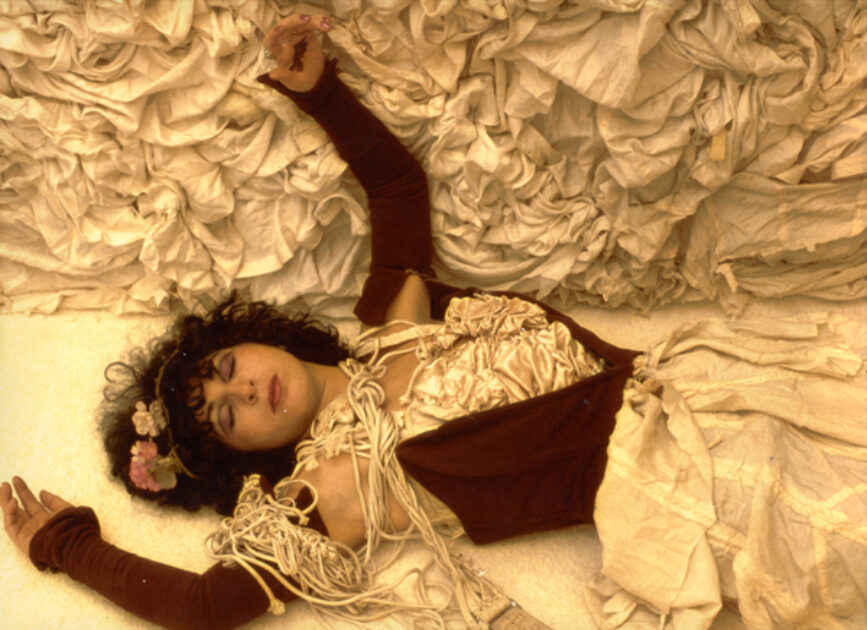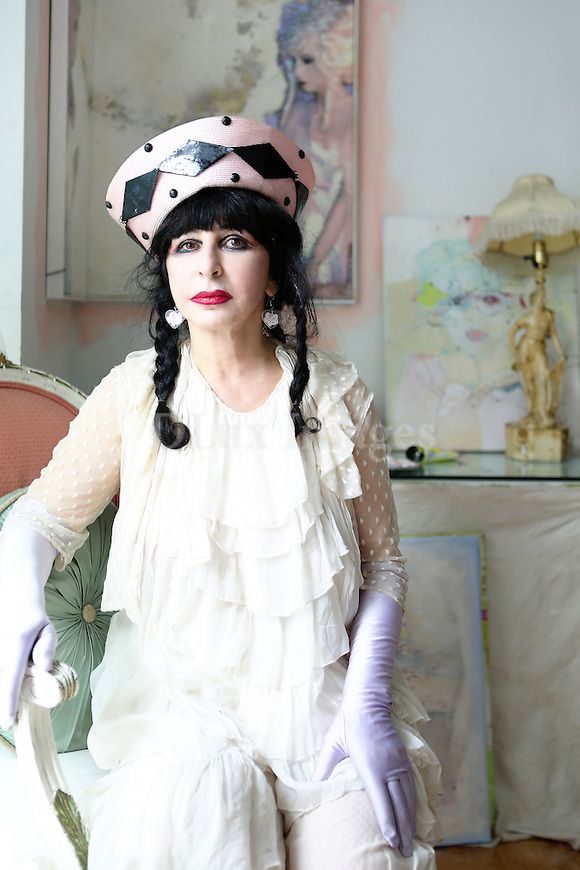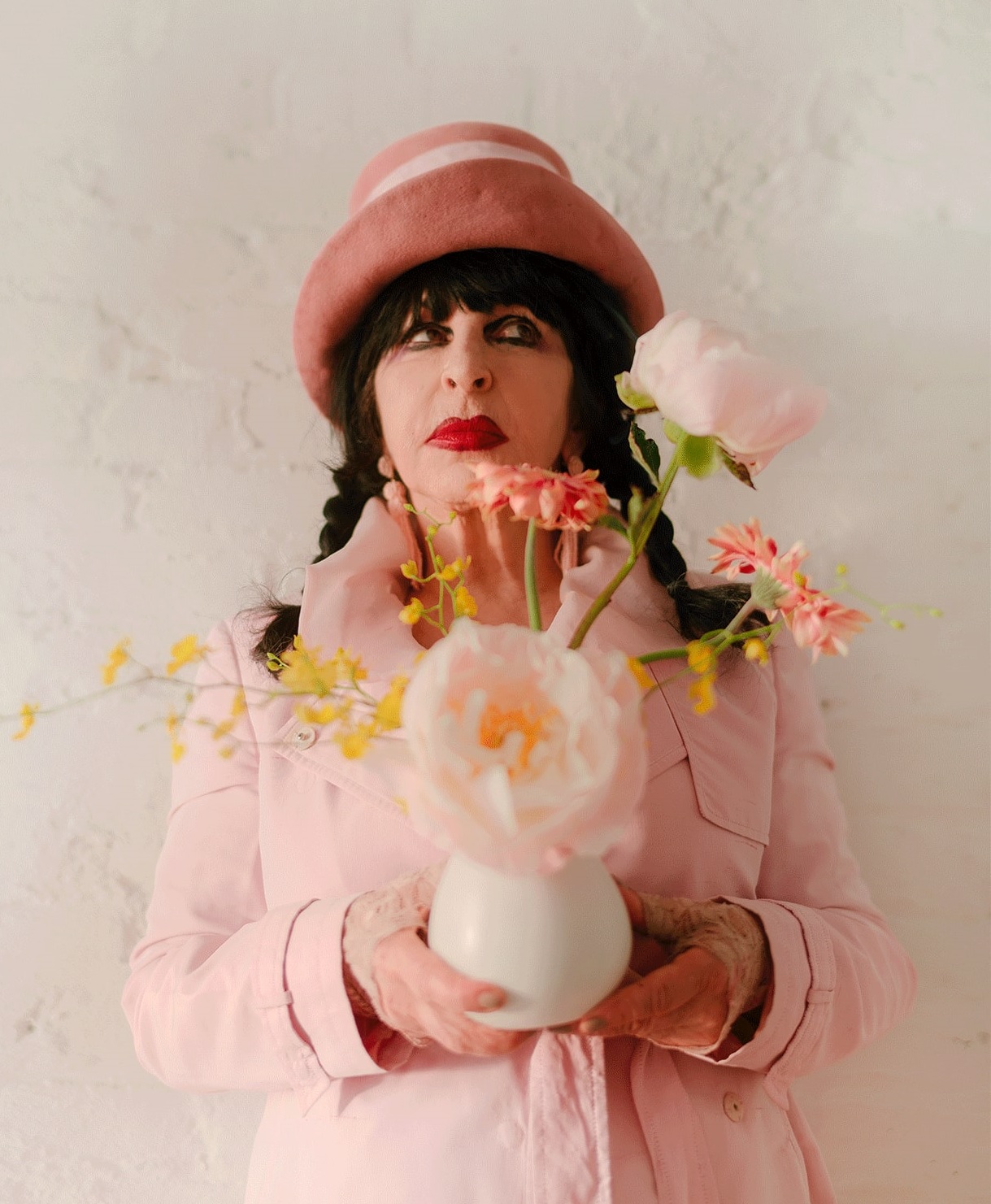
Schwer zu sagen, leicht zu erkennen. Wer fragt, wer oder was Colette wirklich ist, hat vielleicht schon die falsche Frage gestellt. Geburtsname, -ort wie -jahr gibt die Künstlerin partout nicht preis. Sonst aber wirklich alles. Colette, oder Colette Lumiere ist ein wandelndes Living Environment und seit sagenhaften 50 Jahren unverkennbar in ihrem selbstgeschneiderten Rüschenkleid und den zerzausten pechschwarzen Haaren unterwegs. Sie ist Pop und Punk, Pionierin und letzte Bohémienne, Kunst-Ikone und Kitsch-Liese. Weil sie allem Kommerz kritisch gegenübersteht, „aber immer noch arm wie eine Kirchenmaus“. Jetzt stellt sie auf der Art Basel aus.
Als „Justine” posierte sie als Model in ihren eigenen Innenarchitekturen, als weiblicher Punk trat sie Frontfrau der Band Justine & the Victorian Punks auf, als Erfinderin von Produkten, die von Colettes selbstgeschaffenem Bild inspiriert waren, reist sie um die Welt und leistet Schwerstarbeit als Verwalterin ihres eigenen Nachlasses.

Schon 1978 inszenierte sie in einer frühen Performance ihren Tod (Colette is Dead) im New Yorker Whitney Museum, um einen Tag später im MoMA PS1 als Justine wieder aufzuerstehen.
In New York traf sie auf eine Gruppe amerikanischer Konzeptkünstler. „Soweit ich mich erinnere, war ich damals die einzige Frau, und wahrscheinlich auch die jüngste”, erinnert sie sich. Als eine der wenigen Frauen, die damals in der Galerie ausstellten, fühlte sie sich wie ein „schwarzes Schaf”. Während viele ihrer männlichen Kollegen zu größtem Erfolg gelangten, spottete Lumiere in ihren Werken über die Kommerzialität oder entzog sich ihr.

Hier lernte sie Dennis Oppenheim und Roger Welch kennen, zwei Konzeptkünstler, die ebenfalls in der Galerie vertreten waren. „Ich hatte eine Liebesaffäre mit beiden”, erinnert sich Colette. Oppenheim und Welch luden sie ein, im Sommer 1977 durch Europa zu reisen. Als die drei in Basel ankamen, besuchten sie selbstverständlich die Kunstmesse, wo sie auf den Händler Massimo Minini traf. Obwohl sie sich gerade erst kennengelernt hatten, lud Minini Colette zu einem Auftritt auf seinem Stand ein. Von der weiten Reise etwas beansprucht, nutzte sie das Angebot, um sich auszuruhen. „Ich legte mich in eine Ecke der Koje und schlief so lange ich konnte“.
Ihre Postkarten – Aufzeichnungen ihres Lebens – hatte sie zuvor aus ihrer Schachtel genommen und an den Wänden hinter sich aufgereiht. Der improvisierte Auftritt wurde zur Sensation.
Der Schlaf überhaupt wird zum Thema ihrer künstlerischen Arbeit. Es begann mit The Transformation of the Sleeping Gypsy without the lion (nach Herni Rousseau) in der Stefanotty Gallery 1973. Ihr Schlafzimmer in New York wurde zum berühmtesten der Welt, nimmt man Tracey Emins My Bed (1998) einmal aus. Sowohl Jeff Koons als auch Richard Prince spielten in dem Film Justine and the Boys mit, der in Colettes Living Environment spielt. Die Künstlerin nimmt in Korsett und Federboa ein Bad, untermalt von schräger Discomusik, bevor ihr Mann (gespielt von Prince) nach Hause kommt und sie mit mehreren Männern auf dem Boden liegend vorfindet, schlafend.
2007 sah sich Colette gezwungen, ihr Loft in der Pearl Street in Lower Manhattan aufzugeben. 30 Jahre lang hatte sie dort gelebt und gearbeitet, ein großer Teil ihres künstlerischen Schaffens drohte zerstört zu werden. Ihr immersives Living Environment hatte sie rundrum mit weißem Stoff bespannt. „Ich habe mit Lumpen angefangen”, so Colette, „zunächst mit Fallschirmen, die ich in Überschusslagern der Armee und der Marine kaufen konnte.“ Sie zog für ein paar Jahre nach Berlin. Corona führte sie zurück nach New York.
Obwohl die hedonistischen Tage New Yorks wohl vorbei sind, ist Colette immer noch am Ball. Ihr Nachlass ist mittlerweile gesichert, ihr Schlafzimmer konnte gerettet werden. „Ich glaube, wir befinden uns in einer Übergangsphase”, schätzt sie. Sie bleibt optimistisch. „Ich denke, es ist eine hässliche Geburt, aber es kann ein schönes Ergebnis sein, und darauf zähle ich. Wir brauchen so viele Menschen wie möglich, die diese Vision haben und nicht verrückt werden und in der Angst stecken bleiben.“ Und auch: „Ich denke, was wir brauchen, ist Kunst, die den Geist erhebt.”

‘Being joyful is completely underrated’
Es ist der Company Gallery zu verdanken, dass Colettes kürzlich wieder entdeckte Ruinen eines Traums (Recently Discovered Ruins of a Dream) nun auch in Europa zu sehen sind. Auf der Art Basel feiert ihr Stand die Künstlerin mit einer Einzelausstellung. Die New Yorker Galeristen Sophie Mörner und Taylor Trabulus wollen Colettes „entscheidende Rolle bei der Gestaltung der Performance-Kunstszene” hervorheben. Kurator Kenta Murakami, der Colette in der Company Gallery in der Ausstellung „Notes on Baroque Living” 2022 vorstellte, kommt vielleicht hinter das Geheimnis der ubiquitären wie multidentitären Künstlerin, wenn er sagt: Colette verstärke die Entfremdung, die sie als Künstlerin empfindet, die sich der Schaffung eines utopischen Raums jenseits der Vorstädte verschrieben hat, die sich in den 1970er Jahren in ganz Amerika ausgebreitet hatten. „Ihr Werk steht für das Versprechen, das New York war, das Versprechen der Bohème und das Versprechen der Kunstwelt. Ein Versprechen, das sich heute nur noch wenige leisten können, sei es für Künstler, die versuchen, in unseren Kulturhauptstädten zu leben, oder, in vielen Fällen, für Galerien, die auf Messen ausstellen. Ihre Aussage ist heute umso riskanter und daher umso notwendiger.“
Carl Friedrich Schröer
Wir trafen Colette auf der Art Basel und konnten im via Email ein Gespräch mit ihr führen
What a question!

From „black sheep“ to white sheep. – What does it mean to You coming back to Art Basel with a one-women-show after all?
I’m very happy that a whole younger generation of art lovers is becoming more familiar with my art & history and very enthusiastic. Younger artists , many of them women celebrate and acknowledge my influence. At same time it is a bit ironic or I should say bitter sweet. I feel like an archeologist of my own work and in a way that is exciting because, I have love for ruins (and archaeology) – and they are both recurring themes in my art .
At same time I do not wish for my New Body of works to be overshadowed by my early history .So I am looking forward to show more recent works in the near future.
I have not stopped being active and in the public ever since the 70’s regardless of whether I had support from the art establishment, or not. And yes; I spent a lot of time in Munich 1986-90 (where i was very active as well as) and Berlin 84-85; 2015-2020 with foundation starke. But continued to surface in exhibitions in nyc even when I was abroad.
In september you will move to Paris. What are your plans and projects there?
Actually even though I obviously applied, it was not my plan, but I trust and embrace what the universe has in mind for me; even though I may at first rebel for having to switch gears. It has always been a desire of mine to spend more time in Paris, and french art history has always been a big inspiration in my work – my choice of heroines, La Liberté, after Delacroix, Madame Recamier and Marat after David, the transformation of the sleeping gypsy without the lion after Henri Rousseau, etc. Even though I am somewhat resistant to change at first, my art is centered around “Home ” yet my life has been nomadic. Aha! I eventually succumb and surrender to unexpected change and a new challenge.
Into which personality will you transfer next?
I have no idea. I never really do. The title for my project for Explora is “Unto the Unknown “. Actually it should be again unto the unknown.
What does it mean to you to be an icon-artist without being famous?
It sucks! ah. Actually I might not have attained the commercial success of many of my peers, who are also more famous but my work is well known, and acknowledged” by those that matter “. It has been for decades, so many artists have vanished from the art scene, after a few years of fame and have not been able to surface again. For the last couple of years, just when I was about to give up arms, I began to attain more commercial sucess! And I’m grateful for it. It seems, I had for a long time resisted commercial success – I did not trust it.
I’m mature enough now to not let it go to my head and use it to preserve my legacy! which is very important at this point of my life and finally have a real book on my lifes work. Every idiot has managed to have a book pubished on their art work by their mid thirties (all it takes is financing).
About two years ago, when I returned to NYC after my exile to Berin (2015-2020) I was throwing my work away. I thought I had reached the end, too many storage problems! and I felt like Atlas carrying my history. I asked for help and lo & behold I received it.
A young curator Kenta Murakami, who was then with Red Bull, created a kick starter project for me. I was at first a bit embarrassed by having to ask for that kind of help he created a beautiful successful campaing that led to a younger enthusiastic audience and gallery representation, the exhibition notes on baroque living – which he curated at Company Gallery nyc (nov 2021 – feb 2022) was a huge sucess. As well I compare myself to a submarine, I may be out of sight for a short time but i always manage to reemerge.
You came in the late 60th as an immigrant to the US. Did change art anything since then?
Yes! Art and the Art world at large has changed tremendously. It would take a book to share my thoughts and experience. One main idea I would like to share is that one of my recurring themes is the blurring of life and art. Art and commerce etc. Now fashion, design, crafts have made their way into art and the line has vanished?
I’m afraid I might be somewhat responsible. Even though it is not my fault how others interpret me. It brings to mind what the well known painter Malcolm Morley kept repeating in the early seventies: “I created monsters”. When he was widely imitated for being the first do bring back realism – (the new realists, early 70’s) and it became such a “shallow means of expression’ but popular and profitable business because easily understood as an art form. As much as I appreciate love, fashion, design, and various other art forms, I share his thinking. There is a good reason why they all have a different name… because they are different!
thanks and love to Colette




